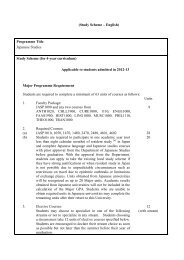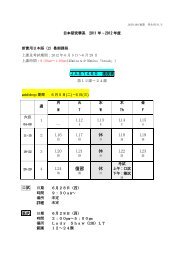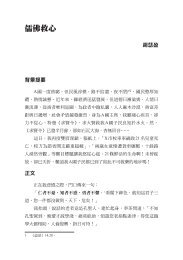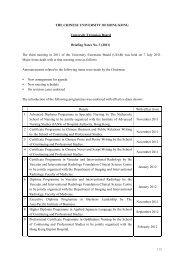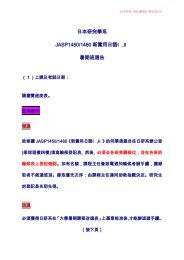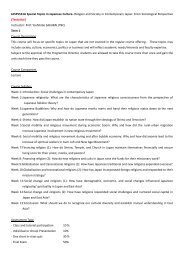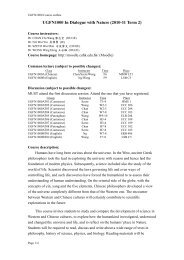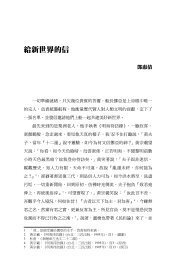8 Special Topic: Assessment in <strong>University</strong> General Education ProgramI have <strong>of</strong>ten seen departments and programs put forth an overly ambitiousgoal, and following the process outlined above will help avoid this problem.It is important to remember that it is much harder to focus our thoughts thanto expend the words necessary to capture diffuse thinking. 5 A clear, concisegoal will positively affect efforts to actually operationalize it with meaningfuloutcomes, learning opportunities, and assessments.Ultimately, the goal <strong>of</strong> a GEP must be translated into statements that areless idealistic and represent clear pathways towards learning and assessment.I espouse a sequence where the overall goal <strong>of</strong> the GEP is followed byobjectives (an optional step) 6 and, finally, by outcomes. Gronlund andBrookhart (2008) <strong>of</strong>fered this approach to classroom teachers. <strong>The</strong>y believethat teachers should begin by articulating their vision for a course (the goal).<strong>The</strong>y should then develop general instructional objectives that are clearerthan the goal but still somewhat vague—that is, “Students will understand. . .” or “Students will appreciate . . . .” Finally, specific learning outcomesshould be stated that capture what students will know and be able to do inmeasurable terms—that is, “Students will recall 7 . . . , ” “Students will explain. . .,” or “Students will judge . . . .” <strong>The</strong> verbs provide a directive for not onlyhow the outcomes should be taught, but also how they can be assessed. Fora list <strong>of</strong> verbs and phrases for each level <strong>of</strong> the Bloom Taxonomy for the5 A quotation is attributed to Blasé Pascal to the effect that he would have made a letter to afriend shorter, but he didn’t have the time.6 Objectives are characterized by verbs like “knows,” “understands,” and “appreciates,”which can help to make the goal more concrete, thus making the statement <strong>of</strong> outcomeseasier. <strong>The</strong>y can serve as an intermediate step that precedes outcomes, although outcomescan, <strong>of</strong> course, emanate directly from the goal.7 “Recall” is a commonly used verb to describe a rudimentary use <strong>of</strong> knowledge. Other verbsfor this level include: choose, define, describe, label, list, locate, match, memorize, name,omit, record, relate, repeat, and select.
Stephen J. Friedman, Outcomes, Learning, and Assessment in General Education 9Cognitive Domain, 8 see Gronlund and Brookfield.Outcomes precisely identify what students will know or be able to doas a result <strong>of</strong> participation in a GEP. Erring on the side <strong>of</strong> fewer outcomesrather than more will have a positive effect on the process (which also makesthe development <strong>of</strong> learning experiences and assessments more manageable).In addition to specific verbs, outcomes can also be described by proposingkey statements or questions to which students might respond as evidence thatthe outcome has been achieved. <strong>The</strong>se are particularly useful for the higherlevels <strong>of</strong> thinking in Bloom’s Taxonomy and serve as a guide for teacherswho are interested in developing classroom activities that demand certainkinds <strong>of</strong> thinking. For example, in order to demonstrate that students canthink at the second level <strong>of</strong> the Taxonomy (comprehension), they might beasked to provide an example that illustrates that they can do more with apiece <strong>of</strong> information than simply memorize it. 9 <strong>The</strong> specific verbs, statements,and questions help determine the precise wording for an outcome that isbeing considered and define the nature <strong>of</strong> the assessment that can be used tomeasure it. I have my own version that I have circulated widely at CUHK andwhenever I speak on this topic (see Appendix I).8 Based on the work by Benjamin Bloom in the 1950s that was not noticed much at thetime, his taxonomy is a key to conceptualizing outcome-based education. It consists <strong>of</strong> sixlevels—knowledge, comprehension, application, analysis, synthesis, and evaluation—thatrepresent increasingly more sophisticated levels <strong>of</strong> thinking whereby a relatively high level<strong>of</strong> thinking is not possible unless the levels below it have been mastered.9 Other statements and questions for the comprehension level include:Give an example <strong>of</strong> . . .State in one word.Condense this paragraphExplain what is happening.State in your own words.Explain what is meant.Show in a graph or a table.Read a table or a graph.Select the best definition.Which statement supports the main idea?Is this the same as . . .?What does this represent?What restrictions would you add? What part doesn’t fit?What exceptions are there?Which is more probable?What are facts? Opinions?What does it mean?
- Page 3: University General Education Bullet
- Page 9: 目 錄卷 首 語 ................
- Page 12 and 13: 彭 森 明 教 授 在 〈 以 學
- Page 14 and 15: 最 新 的 發 展 動 態 和 研
- Page 16 and 17: 2 Special Topic: Assessment in Univ
- Page 18 and 19: 4 Special Topic: Assessment in Univ
- Page 20 and 21: 6 Special Topic: Assessment in Univ
- Page 24 and 25: 10 Special Topic: Assessment in Uni
- Page 26 and 27: 12 Special Topic: Assessment in Uni
- Page 28 and 29: 14 Special Topic: Assessment in Uni
- Page 30 and 31: 16 Special Topic: Assessment in Uni
- Page 32 and 33: 18 Special Topic: Assessment in Uni
- Page 34 and 35: 20 Special Topic: Assessment in Uni
- Page 36 and 37: 22 Special Topic: Assessment in Uni
- Page 38 and 39: 24 Special Topic: Assessment in Uni
- Page 40 and 41: 26 Special Topic: Assessment in Uni
- Page 42 and 43: 28 Special Topic: Assessment in Uni
- Page 44 and 45: 30 Special Topic: Assessment in Uni
- Page 46 and 47: 32 Special Topic: Assessment in Uni
- Page 48 and 49: 34 Special Topic: Assessment in Uni
- Page 50 and 51: 36 Special Topic: Assessment in Uni
- Page 52 and 53: 38 Special Topic: Assessment in Uni
- Page 54 and 55: 40 Special Topic: Assessment in Uni
- Page 56 and 57: 42 Special Topic: Assessment in Uni
- Page 59 and 60: 以 學 習 成 果 為 主 軸 的
- Page 61 and 62: 彭 森 明 : 以 學 習 成 果
- Page 63 and 64: 彭 森 明 : 以 學 習 成 果
- Page 65 and 66: 彭 森 明 : 以 學 習 成 果
- Page 67 and 68: 彭 森 明 : 以 學 習 成 果
- Page 69 and 70: 彭 森 明 : 以 學 習 成 果
- Page 71 and 72: 彭 森 明 : 以 學 習 成 果
- Page 73 and 74:
彭 森 明 : 以 學 習 成 果
- Page 75 and 76:
彭 森 明 : 以 學 習 成 果
- Page 77 and 78:
彭 森 明 : 以 學 習 成 果
- Page 79 and 80:
彭 森 明 : 以 學 習 成 果
- Page 81 and 82:
彭 森 明 : 以 學 習 成 果
- Page 83 and 84:
評 核 大 學 生 在 通 識 教
- Page 85 and 86:
徐 慧 璇 : 評 核 大 學 生
- Page 87 and 88:
徐 慧 璇 : 評 核 大 學 生
- Page 89 and 90:
徐 慧 璇 : 評 核 大 學 生
- Page 91 and 92:
徐 慧 璇 : 評 核 大 學 生
- Page 93 and 94:
徐 慧 璇 : 評 核 大 學 生
- Page 95 and 96:
徐 慧 璇 : 評 核 大 學 生
- Page 97 and 98:
徐 慧 璇 : 評 核 大 學 生
- Page 99 and 100:
徐 慧 璇 : 評 核 大 學 生
- Page 101 and 102:
徐 慧 璇 : 評 核 大 學 生
- Page 103 and 104:
徐 慧 璇 : 評 核 大 學 生
- Page 105 and 106:
徐 慧 璇 : 評 核 大 學 生
- Page 107 and 108:
徐 慧 璇 : 評 核 大 學 生
- Page 109 and 110:
徐 慧 璇 : 評 核 大 學 生
- Page 111 and 112:
徐 慧 璇 : 評 核 大 學 生
- Page 113 and 114:
Why Not Try a Scientific Approach t
- Page 115 and 116:
Carl Wieman, Why Not Try a Scientif
- Page 117 and 118:
Carl Wieman, Why Not Try a Scientif
- Page 119 and 120:
Carl Wieman, Why Not Try a Scientif
- Page 121 and 122:
Carl Wieman, Why Not Try a Scientif
- Page 123 and 124:
Carl Wieman, Why Not Try a Scientif
- Page 125 and 126:
Carl Wieman, Why Not Try a Scientif
- Page 127 and 128:
Carl Wieman, Why Not Try a Scientif
- Page 129 and 130:
Carl Wieman, Why Not Try a Scientif
- Page 131 and 132:
Carl Wieman, Why Not Try a Scientif
- Page 133 and 134:
Carl Wieman, Why Not Try a Scientif
- Page 135:
Carl Wieman, Why Not Try a Scientif
- Page 138 and 139:
124 Teaching and Learning in Genera
- Page 140 and 141:
126 Teaching and Learning in Genera
- Page 142 and 143:
128 Teaching and Learning in Genera
- Page 144 and 145:
130 Teaching and Learning in Genera
- Page 146 and 147:
132 通 識 教 與 學力 等 方
- Page 148 and 149:
134 通 識 教 與 學( 三 ) 在
- Page 150 and 151:
136 通 識 教 與 學己 的 家
- Page 152 and 153:
138 通 識 教 與 學慧 , 推
- Page 154 and 155:
140 通 識 教 與 學承 聯 合
- Page 156 and 157:
142 通 識 教 與 學而 「 兩
- Page 158 and 159:
144 通 識 教 與 學( 一 ) 萬
- Page 160 and 161:
146 通 識 教 與 學這 兩 體
- Page 162 and 163:
148 通 識 教 與 學第 三 定
- Page 164 and 165:
150 通 識 教 與 學根 據 愛
- Page 166 and 167:
152 通 識 教 與 學b. 收 斂
- Page 168 and 169:
154 通 識 教 與 學( 二 ) 攝
- Page 170 and 171:
156 通 識 教 與 學( 一 ) 蝴
- Page 172 and 173:
158 通 識 教 與 學性 的 共
- Page 174 and 175:
160 通 識 教 與 學木 星 質
- Page 176 and 177:
162 通 識 教 與 學L 460ºSPL 3
- Page 178 and 179:
164 通 識 教 與 學( 二 ) 最
- Page 180 and 181:
166 通 識 教 與 學蒸 發 ,
- Page 182 and 183:
168 通 識 教 與 學雙 曲 線
- Page 184 and 185:
170 通 識 教 與 學參 考 書
- Page 186 and 187:
172 通 識 教 與 學17. Wikipedi
- Page 189 and 190:
文 化 、 大 學 文 化 與 通
- Page 191 and 192:
陸 根 書 : 文 化 、 大 學
- Page 193 and 194:
陸 根 書 : 文 化 、 大 學
- Page 195 and 196:
陸 根 書 : 文 化 、 大 學
- Page 197 and 198:
陸 根 書 : 文 化 、 大 學
- Page 199 and 200:
陸 根 書 : 文 化 、 大 學
- Page 201 and 202:
陸 根 書 : 文 化 、 大 學
- Page 203 and 204:
陸 根 書 : 文 化 、 大 學
- Page 205 and 206:
陸 根 書 : 文 化 、 大 學
- Page 207 and 208:
陸 根 書 : 文 化 、 大 學
- Page 209 and 210:
陸 根 書 : 文 化 、 大 學
- Page 211 and 212:
陸 根 書 : 文 化 、 大 學
- Page 213 and 214:
陸 根 書 : 文 化 、 大 學
- Page 215 and 216:
陸 根 書 : 文 化 、 大 學
- Page 217:
陸 根 書 : 文 化 、 大 學
- Page 220 and 221:
206 論 壇實 處 。 1 十 幾
- Page 222 and 223:
208 論 壇那 麼 , 事 實 與
- Page 224 and 225:
210 論 壇主 義 和 人 文 主
- Page 226 and 227:
212 論 壇高 校 引 進 精 品
- Page 228 and 229:
214 論 壇的 數 量 維 持 在
- Page 230 and 231:
216 論 壇向 , 學 生 的 興
- Page 232 and 233:
218 論 壇大 堆 泛 泛 的 「
- Page 234 and 235:
220 論 壇9. 殷 小 平 (2007)。
- Page 236 and 237:
222 論 壇專 業 的 入 門 課
- Page 238 and 239:
224 論 壇程 》 一 書 中 極
- Page 240 and 241:
226 論 壇度 作 構 圖 。 他
- Page 242 and 243:
228 論 壇改 為 寺 廟 為 主
- Page 244 and 245:
230 論 壇名 氣 有 多 大 ,
- Page 246 and 247:
232 論 壇詩 的 優 劣 則 使
- Page 248 and 249:
234 論 壇他 們 運 用 自 如
- Page 250 and 251:
236 論 壇七 十 年 代 , 美
- Page 252 and 253:
238 論 壇8. Torff, B. & Sternberg



